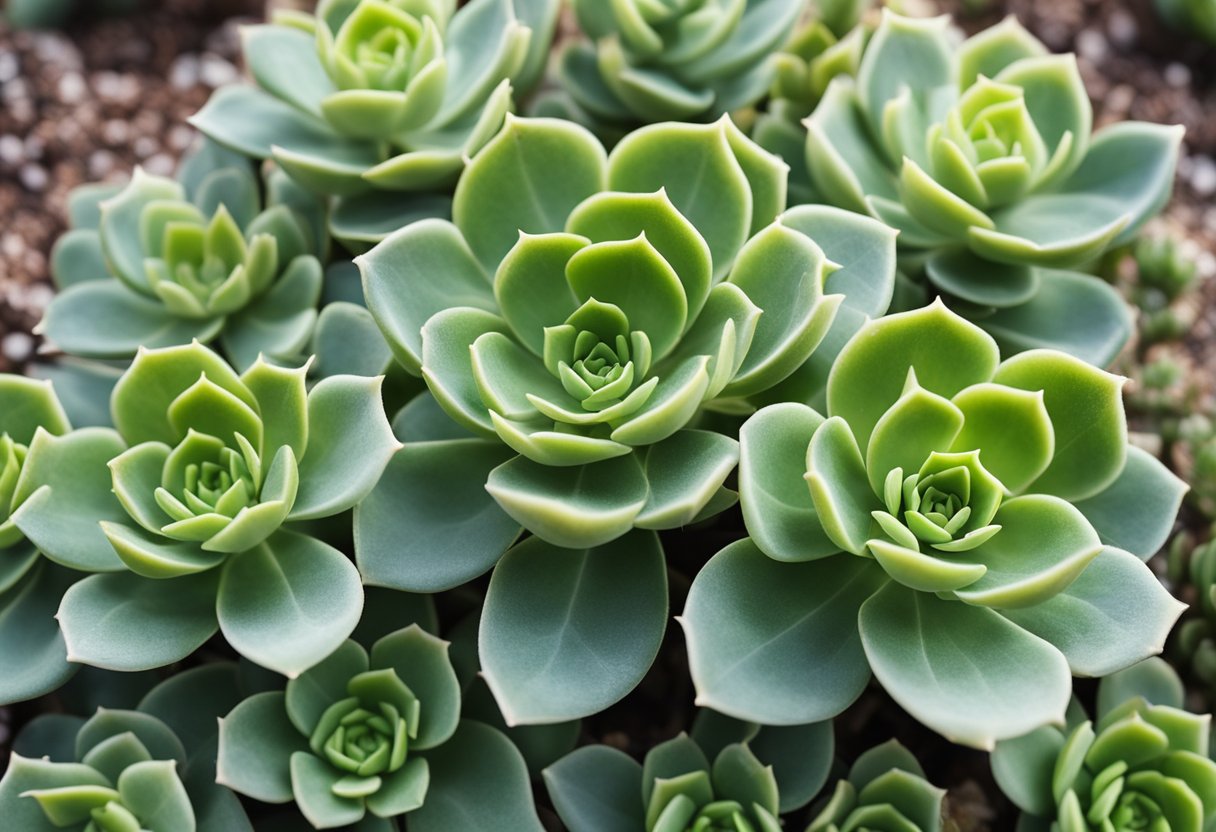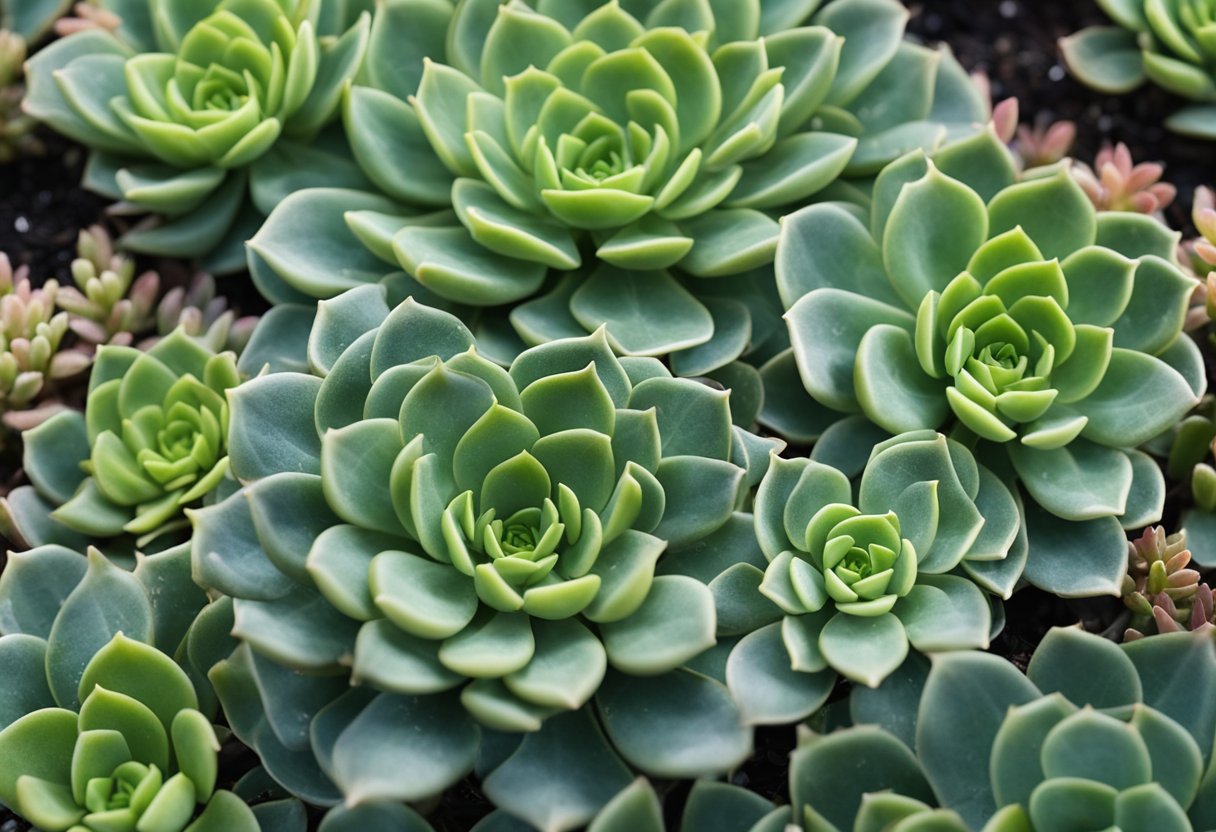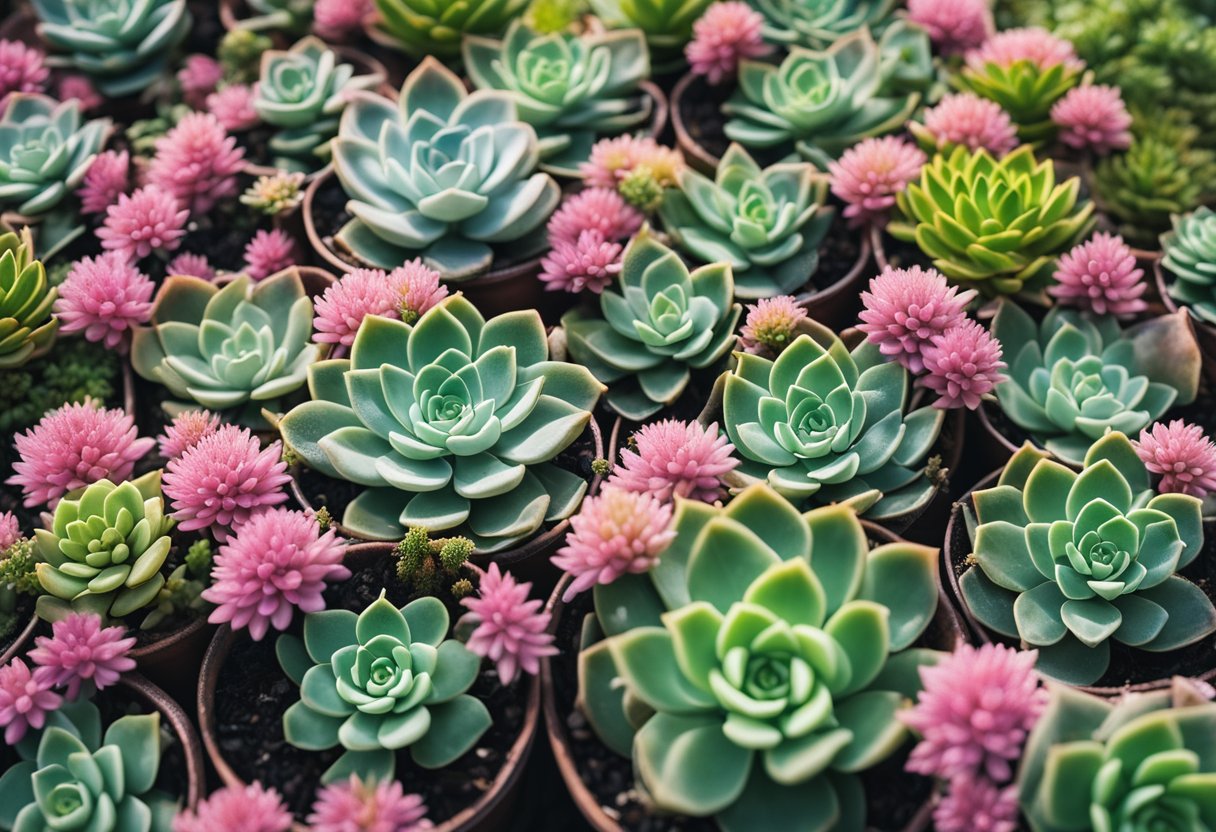Different Types of Sedum Succulents: A Comprehensive Guide
Sedum succulents are a diverse group of plants that are known for their beauty, resilience, and low maintenance requirements. These plants are part of the Crassulaceae family and are commonly referred to as stonecrops. Sedums come in a variety of shapes, sizes, and colors, making them a popular choice for gardeners and succulent enthusiasts alike.
This post may contain affiliate links, which means I’ll receive a commission if you purchase through my link, at no extra cost to you. Please read full disclosure here.

There are over 400 different types of sedum plants, each with its own unique characteristics. Some sedums are low-growing and make excellent groundcovers, while others are tall and upright and are perfect for adding height and texture to a garden. Sedums are also known for their attractive flowers, which range in color from white and pink to red and yellow.
Whether you’re looking for a creeping type of sedum as a groundcover or for an upright sedum known for attracting bees and butterflies, there is a sedum variety that will suit your needs. In this article, we will explore some of the most popular types of sedum succulents and provide information on their care and maintenance.
Understanding Sedums

Sedums are a diverse group of succulent plants that belong to the Crassulaceae family. These plants are commonly known as stonecrop and are popular for their beauty, resilience, and low maintenance requirements.
Sedums come in many different varieties, including upright sedums and creeping sedums. Upright sedums have dense, domed flowers and succulent leaves on 1- to 2-foot stems. These taller sedum varieties generally behave like perennials and do well in zones 4 or 5 to 9, with a layer of winter mulch recommended in zones 4 and 5. Creeping sedums, on the other hand, are low-growing and spread easily. They are perfect for ground cover or as a border plant.
Sedums are known for their ability to store water, making them an ideal plant for dry climates or for those who want a low-maintenance garden. They are also resistant to pests and diseases, making them a great choice for beginners.
Overall, sedums are a versatile and beautiful addition to any garden. With so many different varieties to choose from, there is sure to be a sedum that will fit your needs and preferences.
Varieties of Sedums

Sedums are a diverse group of succulents that come in various shapes, sizes, and colors. They are easy to care for and can thrive in a wide range of growing conditions. Here are some of the popular sedum varieties:
-
Sedum morganianum: Commonly known as Burro’s Tail, this sedum has long, trailing stems covered in plump, blue-green leaves. It’s a great choice for hanging baskets or as a trailing plant in a mixed succulent container.
-
Sedum rubrotinctum: Also called Jelly Bean Plant, this sedum has small, jellybean-shaped leaves that turn red in bright sunlight. It’s a popular choice for indoor succulent gardens and can be propagated easily from stem cuttings.
-
Sedum spectabile: Known as Showy Stonecrop, this sedum produces large clusters of pink flowers in late summer and fall. It’s a great choice for adding color to a sunny border or mixed perennial bed.
-
Sedum reflexum: Also called Blue Spruce, this sedum has needle-like blue-green leaves that resemble the foliage of a spruce tree. It’s a low-growing sedum that works well as a groundcover or in rock gardens.
-
Sedum spurium: Commonly known as Two-Row Stonecrop, this sedum has small, round leaves that form a dense mat. It’s a great choice for planting between stepping stones or as a groundcover in a sunny spot.
-
Sedum rupestre: Also called Reflexed Stonecrop, this sedum has small, needle-like leaves that turn bronze in fall. It’s a great choice for rock gardens or as a groundcover in poor soil.
-
Sedum adolphii: Known as Golden Sedum, this sedum has fleshy, yellow-green leaves that turn orange-red in bright sunlight. It’s a great choice for adding color to a mixed succulent container or as a trailing plant in a hanging basket.
-
Sedum album: Also called White Stonecrop, this sedum has small, white flowers that bloom in late summer. It’s a great choice for adding texture to a sunny border or rock garden.
-
Sedum dasyphyllum: Known as Blue Tears, this sedum has tiny, blue-green leaves that form a dense mat. It’s a great choice for planting between stepping stones or as a groundcover in a sunny spot.
-
Sedum nussbaumerianum: Also called Coppertone Stonecrop, this sedum has fleshy, copper-colored leaves that turn reddish in bright sunlight. It’s a great choice for adding color to a mixed succulent container or as a trailing plant in a hanging basket.
-
Sedum kamtschaticum: Known as Russian Stonecrop, this sedum has small, yellow flowers that bloom in early summer. It’s a great choice for adding color to a rock garden or as a groundcover in a sunny spot.
-
White Stonecrop: This sedum has small, white flowers that bloom in late summer. It’s a great choice for adding texture to a sunny border or rock garden.
-
Moss Stonecrop: This low-growing sedum has tiny, moss-like leaves that form a dense mat. It’s a great choice for planting between stepping stones or as a groundcover in a sunny spot.
-
Gold Moss: This hardy, low-growing sedum has small, yellow-green leaves that form a dense mat. It’s a great choice for rock gardens or as a groundcover in poor soil.
-
Blue Spruce: This sedum has needle-like blue-green leaves that resemble the foliage of a spruce tree. It’s a low-growing sedum that works well as a groundcover or in rock gardens.
-
Jelly Bean: This sedum has small, jellybean-shaped leaves that turn red in bright sunlight. It’s a popular choice for indoor succulent gardens and can be propagated easily from stem cuttings.
-
Purple Emperor: This sedum has dark purple leaves that form a dense mat. It’s a great choice for adding color to a mixed succulent container or as a groundcover in a sunny spot.
-
Pure Joy: This sedum has blue-green leaves that turn red in bright sunlight. It’s a great choice for adding color to a mixed succulent container or as a trailing plant in a hanging basket.
-
Herbstfreude: Also called Autumn Joy, this sedum produces large clusters of pink flowers in late summer and fall. It’s a great choice for adding color to a sunny border or mixed perennial bed.
Physical Characteristics
Sedum succulents are known for their unique physical characteristics that make them stand out from other plants. They come in a wide range of sizes, from small ground covers to taller plants that can grow up to 2 feet tall. The height of the sedum plant depends on the variety, with some growing low to the ground and others growing upright.
Sedum succulents have foliage that can range in color from green to copper. The leaves of sedum plants are fleshy and succulent, which allows them to store water and survive in arid conditions. The leaves can be either round or elongated, and some varieties have leaves that are shaped like stars or other unique shapes.
The foliage of sedum plants can be dense, with leaves growing closely together, or more spread out. This depends on the variety of sedum plant, with some having a more compact growth habit than others. Sedum plants are known for their ability to spread quickly, which makes them a great choice for ground covers.
In terms of shape, sedum plants can be upright or creeping. Upright sedums have dense, domed flowers and succulent leaves on 1- to 2-foot stems. These taller sedum varieties generally behave like perennials and do well in zones 4 or 5 to 9, with a layer of winter mulch recommended in zones 4 and 5. Creeping sedums, on the other hand, produce clusters of star-shaped flowers and are great for use as ground covers.
Overall, sedum succulents are unique and interesting plants that come in a wide variety of shapes, sizes, and colors. Their fleshy, succulent leaves and ability to store water make them well-suited for dry conditions, while their dense foliage and ability to spread quickly make them a great choice for ground covers.
Planting and Care
Sedums are easy-to-grow succulents that require minimal care and maintenance. They thrive in well-drained soil and full sun, but can also tolerate partial shade. Sedums are drought-tolerant and can survive in a variety of climates and hardiness zones.
When planting sedums, it is important to choose a well-draining soil that is not too rich in organic matter. Sedums prefer a soil that is slightly acidic to neutral with a pH range of 6.0 to 7.5. They also prefer a soil that is not too wet, as this can lead to root rot.
Watering sedums is easy, as they do not require frequent watering. They should be watered deeply once a week during the summer months and once every two to three weeks during the fall. Sedums do not require fertilizer, but a light application of a balanced fertilizer in the spring can help promote growth.
Pruning sedums is not necessary, but can help keep them looking neat and tidy. Deadheading spent blooms can encourage new growth and prolong the blooming period. Sedums can also be divided every few years to prevent overcrowding and promote healthy growth.
Overall, sedums are low-maintenance plants that are perfect for gardens and landscapes. With their vibrant colors and attractive foliage, they can add interest and texture to any outdoor space.
Propagation Techniques
Sedums are easy to propagate and make great additions to any succulent garden. There are three main ways to propagate sedums: by seeds, leaf cuttings, and stem cuttings. Each method has its own advantages and disadvantages.
Propagation by Seeds
Propagation by seeds is the most time-consuming method but is the only way to get new varieties. To propagate sedums by seeds, the seeds should be sown in a well-draining soil mix and kept moist. The seeds will germinate in a few weeks, and the seedlings can be transplanted once they are large enough to handle.
Propagation by Leaf Cuttings
Propagation by leaf cuttings is the easiest and most common method. Simply separate a leaf of the plant from the stem, let it dry out for a day or two, then place it in well-draining soil. The leaf will form roots and a new plant will grow from the base. This method is suitable for small sedum varieties.
Propagation by Stem Cuttings
Propagation by stem cuttings is another easy method and is suitable for larger sedum varieties. Choose a healthy sedum plant and locate a stem that is at least 3-4 inches long. Make sure the stem has several sets of leaves. Using a sharp, clean knife or pair of scissors, cut the stem just below a set of leaves. Remove the lower leaves and place the cutting in well-draining soil. Water the cutting and keep it moist until it roots.
Overall, propagation is a great way to expand your sedum collection and create a beautiful succulent garden. Whether you choose to propagate by seeds, leaf cuttings, or stem cuttings, make sure to use well-draining soil and keep the cuttings moist until they root.
Uses of Sedums
Sedums are versatile and easy-to-grow succulent plants that can be used in a variety of ways in the garden. Here are some common uses of sedums:
Ground Cover: Sedums are excellent ground covers that can quickly fill in bare spots in the garden. They spread easily and form a dense mat of foliage that can help prevent soil erosion and suppress weeds.
Containers: Sedums are also great container plants. They can be grown in pots, hanging baskets, and other containers. They are drought-tolerant and can survive in small pots without much watering.
Rock Gardens and Rock Walls: Sedums are perfect for rock gardens and rock walls. They thrive in rocky soil and can be used to create a natural-looking landscape. They also add color and texture to rock gardens and rock walls.
Green Roofs: Sedums are becoming increasingly popular for green roofs. They are drought-tolerant and can survive in harsh conditions. They also help to insulate buildings and reduce energy costs.
Slopes: Sedums are ideal for planting on slopes. They have shallow roots that can help prevent soil erosion and stabilize the soil. They also require little maintenance and can survive in dry conditions.
Overall, sedums are a great addition to any garden. They are easy to care for and can be used in a variety of ways. Whether you need a ground cover, container plant, or a plant for a rock garden, sedums are a great choice.
Attracting Pollinators
Sedums are a great addition to any garden, not only because of their attractive appearance but also because they can attract pollinators like butterflies and bees. The star-shaped flowers of sedums are particularly attractive to pollinators, making them an excellent choice for gardeners who want to support local ecosystems.
Pollinators play a critical role in the reproduction of plants, and sedums are no exception. The blooms of sedums provide a valuable source of nectar and pollen for pollinators, which in turn helps to ensure the continued health and vitality of the sedum plants themselves.
If you want to attract pollinators to your garden, consider planting a variety of sedums with different bloom times. This will provide a continuous source of nectar and pollen throughout the growing season, ensuring that pollinators have plenty of food to sustain them.
In addition to providing a food source for pollinators, sedums can also provide shelter and nesting sites. Many species of butterflies and bees will lay their eggs on or near sedums, and the plants can provide a safe haven for caterpillars and other insect larvae.
Overall, sedums are an excellent choice for gardeners who are interested in supporting local ecosystems and attracting pollinators to their gardens. With their attractive appearance and valuable role in supporting local wildlife, sedums are a must-have for any garden.
Pests and Diseases
Sedum succulents are known for their hardiness and resilience to pests and diseases. However, they are not completely immune to these issues. Here are some common pests and diseases that can affect sedums and how to prevent and treat them.
Pests
Aphids
Aphids are small, soft-bodied insects that feed on the sap of plants. They can cause stunted growth, yellowing leaves, and distorted foliage. To prevent aphids, keep your sedum healthy and well-watered. You can also introduce natural predators like ladybugs or lacewings to your garden. If you notice aphids on your sedum, you can spray them off with a strong jet of water or use insecticidal soap.
Diseases
Root Rot
Root rot is a fungal disease that affects the roots of plants. It is caused by overwatering or poor drainage. Symptoms of root rot include yellowing leaves, wilting, and a foul smell. To prevent root rot, make sure your sedum is planted in well-draining soil and that the pot has drainage holes. If you suspect root rot, remove the affected plant from the soil, cut off any affected roots, and repot the plant in fresh, dry soil.
Powdery Mildew
Powdery mildew is a fungal disease that affects the leaves of plants. It appears as a white, powdery coating on the leaves and can cause them to yellow and wilt. To prevent powdery mildew, make sure your sedum is planted in a location with good air circulation and that the leaves are not overcrowded. If you notice powdery mildew on your sedum, you can treat it with a fungicide or a mixture of baking soda and water.
Overall, with proper care and attention, sedums can thrive and be resilient to pests and diseases.